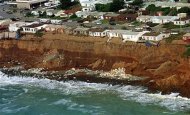Weather center: 50 percent chance of El Nino later this year
Reuters – Thu, Jun 7, 2012
NEW YORK (Reuters) - There is a 50 percent chance the feared
El Nino weather pattern which
can trigger droughts in Southeast
Asia and Australia and
floods in South America may
strike later this year, the U.S.
Climate Prediction Center warned on Thursday.
In its strongest prediction so far that El Nino could emerge, the CPC said
conditions are still expected to be neutral between June and August, but there
is a 50 percent likelihood that El Nino will develop in the remainder of the
year.The CPC issues an El Nino watch when conditions are favorable for the coming six months. In its last update in May, it said it was still uncertain if it would develop.
El Nino is a warming of sea surface temperatures in the tropical Pacific that occurs every four to 12 years and has far-ranging effects around the globe, particularly on food output.
The CPC forecast will be closely watched by the U.S. crude oil industry as El Nino reduces the chances of storms in the Gulf of Mexico that could topple platforms and rigs there.
Forecasters have already said they expect the Atlantic hurricane season, which started on Friday and runs to November 30, to be less active than last year.
The phenomenon creates wind shear that makes it harder for nascent storms to develop into hurricanes in the Atlantic-Caribbean basin, but it also can produce drought and crop failure in parts of South Asia and unseasonably wet conditions in western coastal areas of South America.
While drier conditions could benefit crops such as coffee and cocoa, which were hit by heavy rains last year, analysts have warned that prolonged heat can also hurt yields.
Malaysia and Indonesia account for 90 percent of the world's palm oil supplies, while most of the world's rice is exported from Asia. Asia also produces nearly 40 percent of global wheat supplies and the bulk of natural rubber output.
The last severe El Nino in 1998 killed more than 2,000 people and caused billions of dollars in damage to crops, infrastructure and mines in Australia and other parts of Asia.
(Reporting by Josephine Mason; Editing by Edwina Gibbs)
@yahoonews on Twitter, become a fan on Facebook

No comments:
Post a Comment